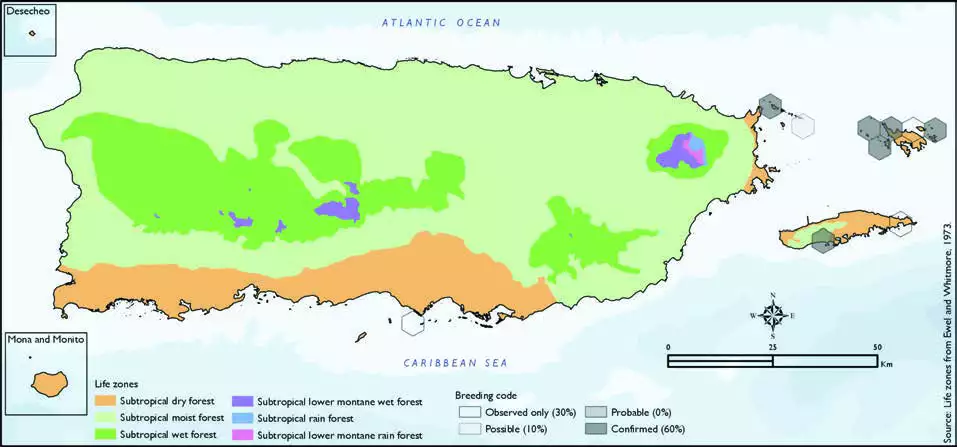Red-billed Tropicbird
Description
The red-billed tropicbird (Phaethon aethereus) is a tropicbird, one of three closely related species of seabird of tropical oceans. Superficially resembling a tern in appearance, it has mostly white plumage with some black markings on the wings and back, a black mask and, as its common name suggests, a red bill. Most adults have tail streamers that are about two times their body length, with those in males being generally longer than those in females. The red-billed tropicbird itself has three subspecies recognized, including the nominate. The subspecies mesonauta is distinguished from the nominate by the rosy tinge of its fresh plumage, and the subspecies indicus can be differentiated by its smaller size, more restricted mask, and more orange bill. This species ranges across the tropical Atlantic, eastern Pacific, and Indian Oceans. The nominate is found in the southern Atlantic Ocean, the subspecies indicus in the waters off of the Middle East and in the Indian Ocean, and the subspecies mesonauta in the eastern portions of both the Atlantic and the Pacific Oceans and in the Caribbean. It was one of the many species described by Carl Linnaeus in his 1758 10th edition of Systema Naturae.
The red-billed tropicbird measures 90 to 105 cm (35 to 41 in) on average,[15] which includes the 46 to 56 cm (18 to 22 in)-long tail streamers.[10] Without them the tropicbird measures about 48 cm (19 in).[15] It has a wingspan of 99 to 106 cm (39 to 42 in).[10] In overall appearance it is tern-like in shape.[16] Its plumage is white, with black wing tips, and a back that is finely barred in black.[17] It has a black mask that extends up from just above the lores to the sides of its nape, with gray mottling usually seen near the nape and hindneck. The tail has black shaft streaks, as do tail streamers. The underparts are white, with some black on the outermost primaries and tertials and occasionally with black markings on the flanks. The iris is blackish-brown, and the bill is red.[17] The legs, base of the central toe, and parts of the outer toes are orange-yellow while the rest of the feet are black. Although the sexes are similar,[10] the males are generally larger than females,[18] with the tail streamers being around 12 cm (4.7 in) longer on the male than on the female.[11]
Distribution & Habitat
The Red-billed Tropicbird occurs throughout the tropical and
subtropical Atlantic Ocean, as
well as through the northwestern
Indian and eastern Pacific
Oceans (Biaggi 1997, Raffaele
and others 1998). It has been
described as common in the Virgin Islands and uncommon
in the Lesser Antilles (Kepler
and Kepler 1978, Raffaele and
others 1998). In Puerto Rico, it
is described as uncommon off
its nesting sites near Culebra
(Oberle 2018). However, it is
also present on Vieques, where
it is considered rare in spring and extremely rare in summer,
fall, and winter (Gemmill 2015).
It nests on small rocky islands
and cays, and will nest on sea
cliffs on larger islands. Rarely
seen around land except when
breeding, it otherwise feeds well
out at sea (Biaggi 1997, Raffaele
and others 1998). The atlas
fieldwork yielded a total of 15
records within 10 hexagons or 2
percent of the 479 total hexagons
(see map). Of the 10 hexagons
where this species was found,
breeding met the atlas definition
of confirmed in 60 percent (six)
of the hexagons and possible
in 10 percent (one), while the
species was observed in 30
percent (three) of the hexagons
but without evidence of breeding
(see map).Red-billed Tropicbird distribution. The map shows the highest breeding code by hexagon and overlaying the ecological life zones in
Puerto Rico. Note: percentages may not total 100 due to rounding. 131Red-billed Tropicbird/Chirre Piquirrojo

Breeding Habits
Previously published reports indicate that the Red-billed
Tropicbird breeds primarily from
January to June, but breeding
has been recorded as early as
late September (Raffaele and
others 1998). This species nests
in small colonies on sea cliffs,
roofs of coastal rocky caves, and
rock crevices of small remote
cays (Biaggi 1997, Raffaele
and others 1998). Atlas results
indicate that this species breeds
between March and June with
the most breeding activity during
the months of March and June, and to a lesser extent also during
April (see chart). Results show
that this species breeds mostly
in coastal areas within the
subtropical dry forest life zone
(86 percent of the hexagons)
(see table and map). It also
breeds within the subtropical
moist forest life zone (14 percent
of the hexagons) (see table
and map).
Conservation
The Red-billed Tropicbird is currently listed as a species
of least concern by the IUCN
(BirdLife International 2018). Nesting success can be reduced
by cats (Felis spp.) and rats
(Rattus spp.). Oberle (2018)
notes that the population is
approximately 1,800 breeding
pairs and that the species has
undergone a major decline in the
last several centuries. Locally, this
species is not listed in any of the
threatened categories of PRDNER
and USFWS. In Puerto Rico,
the Red-billed Tropicbird has a
protected habitat in land of 4
percent or 7 km2 of the total area covered by the hexagons where
evidence of breeding was found
for this species (166 km2).
Related Species
Family:
tropicbird